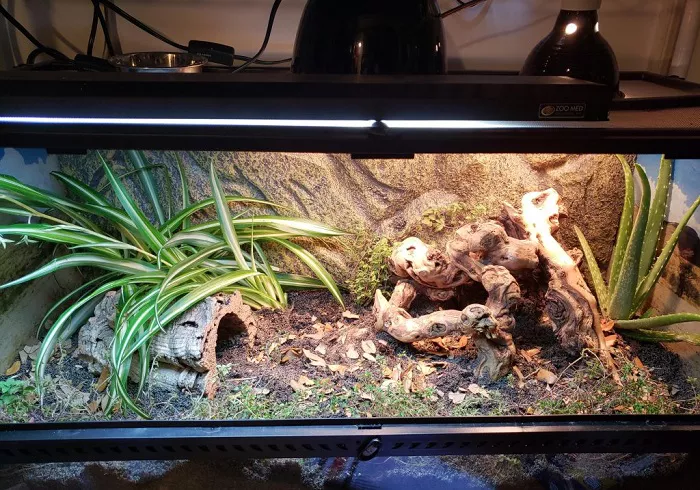Bearded dragons are fascinating creatures that thrive in environments that mimic their natural habitats. Adding plants to their tanks not only enhances the visual appeal but also provides essential enrichment and a sense of security. However, choosing the right plants is crucial to ensure the health and well-being of these reptiles. This article explores the best plant options, their benefits, and how to safely incorporate them into a bearded dragon tank.
Selecting the Right Plants
Natural Habitat Mimicry
Bearded dragons originate from the arid and semi-arid regions of Australia. Their natural environment consists of sparse vegetation, rocks, and sandy soil. When selecting plants for their tanks, it’s essential to choose species that can thrive in similar conditions. These plants should be hardy, drought-tolerant, and able to withstand the high temperatures and low humidity levels typical of a bearded dragon enclosure.
Safe and Non-Toxic Options
Safety is paramount when choosing plants for a bearded dragon tank. Many common houseplants can be toxic to reptiles if ingested. Therefore, it’s crucial to select non-toxic species. Some safe options include:
- Pothos (Epipremnum aureum): This hardy vine is easy to care for and can tolerate low light conditions. It adds a touch of greenery without posing a threat to your bearded dragon.
- Spider Plant (Chlorophytum comosum): Known for its air-purifying qualities, the spider plant is also safe for reptiles. Its long, arching leaves provide visual interest and can be a great addition to a terrarium.
- Haworthia: A small, low-growing succulent that thrives in well-drained soil and bright, indirect light. Its rosette shape adds a unique aesthetic to the tank.
Benefits of Live Plants
Incorporating live plants into a bearded dragon tank offers several benefits. Firstly, plants provide natural hiding spots and climbing opportunities, which are essential for the dragon’s mental and physical well-being. They also help maintain humidity levels, which can be beneficial for shedding. Additionally, live plants contribute to a more natural and aesthetically pleasing environment.
Plant Placement and Care
Strategic Placement
When placing plants in a bearded dragon tank, consider their size and growth habits. Larger plants can be positioned at the back or sides of the enclosure to create a sense of depth and provide shade. Smaller plants can be placed in the front or middle to offer hiding spots and visual barriers. Ensure that the plants do not obstruct the basking area or the UVB light.
Soil and Potting
Using the right soil is crucial for the health of both the plants and the bearded dragon. Opt for a well-draining, reptile-safe soil mix. Avoid using soil that contains fertilizers, pesticides, or perlite, as these can be harmful if ingested. Potting plants in individual containers can make maintenance easier and prevent them from being uprooted by the dragon.
Watering and Maintenance
Bearded dragons require a clean and dry environment, so it’s important to water plants sparingly. Overwatering can lead to mold and bacterial growth, which can be detrimental to the dragon’s health. Use a spray bottle to mist the plants occasionally, ensuring that the soil remains slightly moist but not waterlogged. Regularly trim any dead or overgrown leaves to maintain the health and appearance of the plants.
Alternative Options: Artificial Plants
Pros and Cons
While live plants offer numerous benefits, artificial plants can also be a viable option for a bearded dragon tank. They are low maintenance, easy to clean, and do not require soil or water. However, they do not provide the same environmental enrichment as live plants. When choosing artificial plants, opt for those made from non-toxic materials and avoid ones with small parts that could be ingested.
Choosing the Right Artificial Plants
Select artificial plants that resemble the natural vegetation found in a bearded dragon’s habitat. Look for sturdy, realistic-looking plants that can withstand the dragon’s movements. Some popular options include plastic cacti, succulents, and small bushes. These can be used to create a natural-looking landscape without the risk of toxicity.
Creating a Balanced Environment
Combining Live and Artificial Plants
For the best of both worlds, consider combining live and artificial plants in the tank. This approach allows you to create a diverse and visually appealing environment while minimizing maintenance requirements. For example, you can place live plants in the background and use artificial plants for hiding spots and climbing structures.
Regular Monitoring
Regardless of whether you use live or artificial plants, regular monitoring is essential. Check the plants for signs of damage, mold, or pests. Ensure that the dragon is not ingesting any plant material and that the plants are not obstructing the flow of air or light. Regularly clean the tank and replace any damaged or worn-out plants to maintain a healthy and safe environment.
Conclusion
Adding plants to a bearded dragon tank can significantly enhance the quality of life for these reptiles. By selecting safe, non-toxic plants and strategically placing them in the enclosure, you can create a natural and enriching environment. Whether you choose live or artificial plants, or a combination of both, the key is to prioritize the safety and well-being of your bearded dragon. With proper care and attention, your dragon will thrive in a beautifully landscaped habitat.


